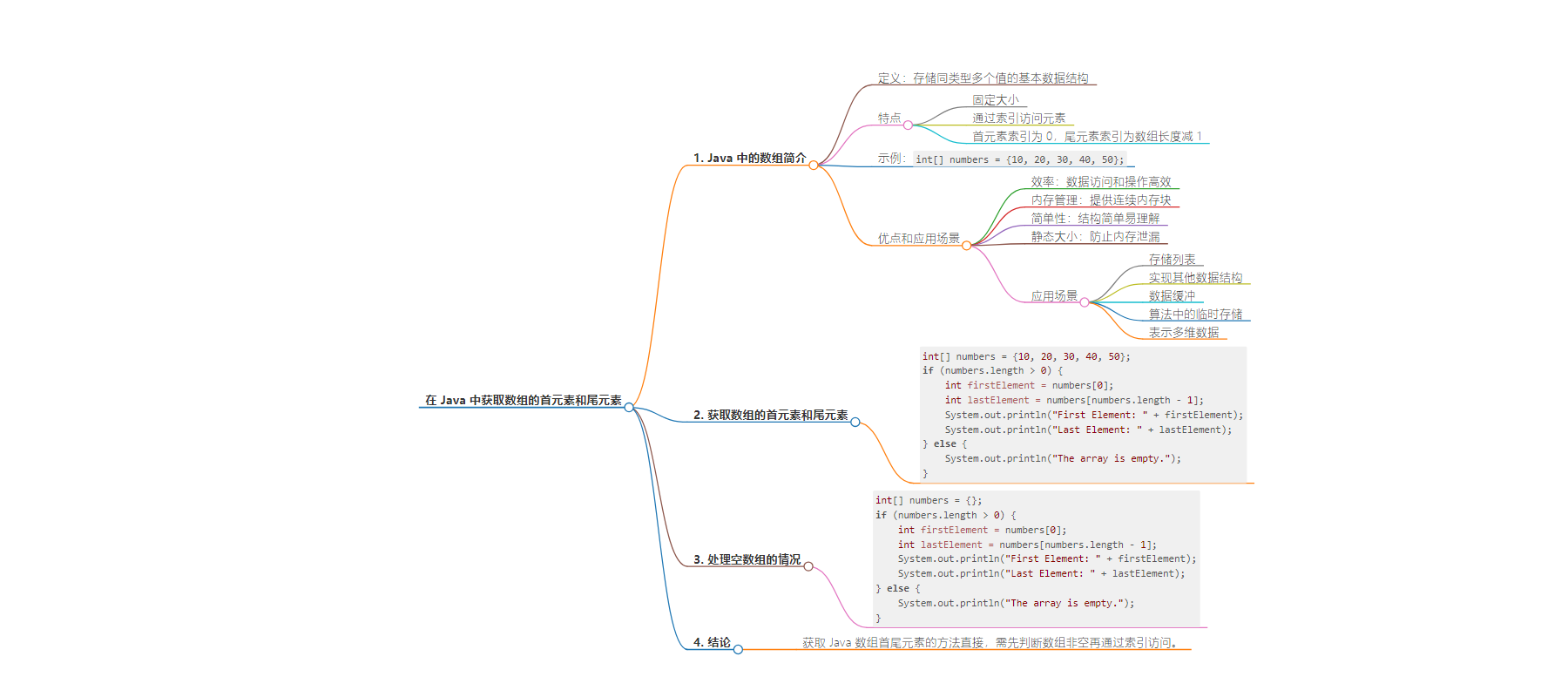包阅导读总结
1. 关键词:Java、数组、元素获取、固定大小、内存管理
2. 总结:
本文主要探讨了在 Java 中从数组获取首末元素的方法。介绍了 Java 数组的概念、优点及用例,展示了获取首末元素的代码示例,强调了处理空数组的重要性,得出获取数组首末元素在 Java 中直接且需注意数组非空的结论。
3. 主要内容:
– Java 中的数组
– 是存储相同类型多个值的基本数据结构
– 固定大小,通过索引访问元素,首元素索引为 0,末元素索引为数组长度减 1
– 数组的优点和用例
– 优点包括高效的数据访问和操作、良好的内存管理、结构简单等
– 用例有存储列表、实现其他数据结构、缓冲数据等
– 获取数组首末元素
– 示例代码展示通过索引获取,需先判断数组非空
– 处理空数组
– 空数组时输出相应提示信息
– 结论
– 在 Java 中获取数组首末元素直接,但要注意数组是否为空
思维导图:
文章地址:https://www.javacodegeeks.com/get-the-first-and-the-last-elements-from-an-array-in-java.html
文章来源:javacodegeeks.com
作者:Yatin Batra
发布时间:2024/7/9 10:11
语言:英文
总字数:516字
预计阅读时间:3分钟
评分:82分
标签:Java,数组,数据结构,编程基础,Java 基础
以下为原文内容
本内容来源于用户推荐转载,旨在分享知识与观点,如有侵权请联系删除 联系邮箱 media@ilingban.com
In this article, we will explore different approaches to getting the first and last elements from an array in Java.
1. What are arrays in Java?
In Java, arrays are a fundamental data structure used to store multiple values of the same type in a single variable. Arrays are fixed in size, and their elements are accessed using an index. The index of the first element is 0, and the index of the last element is the array’s length minus one. Here’s a simple example of an array declaration and initialization in Java:
int[] numbers = {10, 20, 30, 40, 50};
1.1 Benefits and Use Cases of Arrays
- Efficiency: Arrays allow for efficient data access and manipulation due to constant-time complexity (O(1)) for accessing elements by index.
- Memory Management: Arrays provide a contiguous block of memory which can be beneficial for performance due to spatial locality.
- Simplicity: Arrays have a simple structure and are easy to use and understand for basic data storage needs.
- Static Size: Arrays have a fixed size, which can help prevent memory leaks by limiting the number of elements.
- Use Cases:
- Storing a list of items such as numbers, strings, or objects.
- Implementing other data structures like stacks, queues, and matrices.
- Buffering data for input/output operations.
- Temporary storage for sorting and searching algorithms.
- Representing multi-dimensional data, such as 2D arrays for matrices or game boards.
2. Obtaining the First and the Last Elements
To get the first and the last elements of an array in Java, you can use the following approach:
package com.jcg.example;public class Main { public static void main(String[] args) { int[] numbers = {10, 20, 30, 40, 50}; if (numbers.length > 0) { int firstElement = numbers[0]; int lastElement = numbers[numbers.length - 1]; System.out.println("First Element: " + firstElement); System.out.println("Last Element: " + lastElement); } else { System.out.println("The array is empty."); } }}
In the above code:
numbers.length > 0: Checks if the array is not empty.numbers[0]: Accesses the first element of the array.numbers[numbers.length - 1]: Accesses the last element of the array.
The code returns the following output:
First Element: 10Last Element: 50
3. What if the Array Is Empty?
It’s important to handle cases where the array might be empty to avoid errors. In the example above, we checked if the array’s length was greater than 0 before attempting to access its elements. If the array is empty, we print a message indicating that the array is empty.
package com.jcg.example;public class Main { public static void main(String[] args) { int[] numbers = {}; // An empty array if (numbers.length > 0) { int firstElement = numbers[0]; int lastElement = numbers[numbers.length - 1]; System.out.println("First Element: " + firstElement); System.out.println("Last Element: " + lastElement); } else { System.out.println("The array is empty."); } }}
4. Conclusion
In Java, obtaining the first and last elements of an array is straightforward. By checking if the array is not empty, you can safely access these elements using their respective indices. This basic operation is a useful technique for working with arrays in Java.
